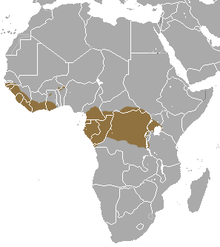Giant pangolin
| Giant pangolin | |
|---|---|
 |
|
| Scientific classification | |
| Kingdom: | Animalia |
| Phylum: | Chordata |
| Class: | Mammalia |
| Order: | Pholidota |
| Family: | Manidae |
| Genus: | Smutsia |
| Species: | S. gigantea |
| Binomial name | |
|
Smutsia gigantea (Illiger, 1815) |
|
 |
|
| Giant pangolin range | |
| Synonyms | |
|
|
The giant pangolin (Smutsia gigantea) is a pangolin species. Members of the species inhabit Africa with a range stretching along the equator from West Africa to Uganda. The giant pangolin is the largest species of pangolins, or "scaly anteaters" – the large, scaled mammals belonging to the family Manidae. It subsists almost entirely on ants and termites. The species was first described by Johann Karl Wilhelm Illiger in 1815.
The giant pangolin is the largest of all pangolin species. While its average mass has not been measured, one specimen was found to weigh 33 kg (72.6 lb). Males are larger than females, with male body lengths about 140 cm (4.6 ft) and females about 125 cm (4.1 ft). Like all pangolins, the species is armored with large, brown to reddish-brown scales formed from keratin. Curiously, it also has eyelashes. The giant pangolin has a long snout, a long, thick tail, and large front claws.
The animal has a strong sense of smell and large anal glands. Its secretions may be significant to animal communication. The species walks with most of its weight is on its columnar rear legs, and curls its front paws, walking on the outside of the wrists rather than the palms to protect the claws. By using its tail for balance, it often walks upright as a biped.
The giant pangolin inhabits many countries, with the largest concentration in Uganda, Tanzania, and western Kenya. It is found mainly in the savanna, rainforest, and forest, inhabiting areas with large termite populations and available water. It does not inhabit high-altitude areas.
...
Wikipedia

